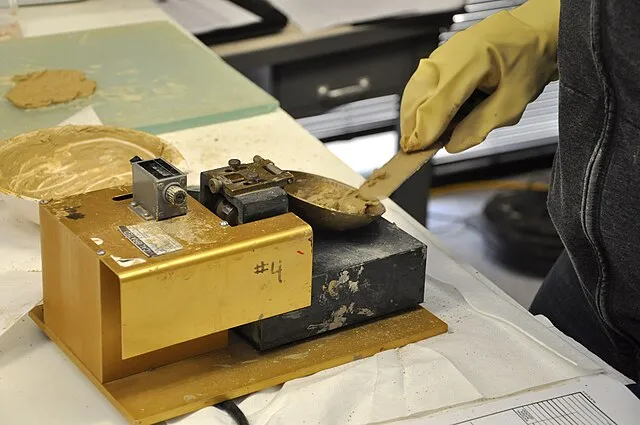What is the Atterberg Limits Test and Why is it Important for Construction?
Understanding the Atterberg Limits Test is essential for soil classification and construction projects. This test helps determine the critical water content of fine-grained soils, which directly impacts their behavior and stability. With over 20 years of experience in geotechnical soil testing, Piers and Piles ensures that construction projects are built on solid and reliable ground, reducing the risk of foundation issues and structural failures.
Are You in Need of Expert Soil Classification? Contact Piers and Piles Today for a Free Consultation!
What Are Atterberg Limits?
Atterberg Limits define the critical water contents of fine-grained soils, which is critical for understanding soil behavior. Developed by Swedish chemist Albert Atterberg, these limits include the Liquid Limit, Plastic Limit, and Shrinkage Limit. Each limit provides valuable insights into the soil’s consistency and its suitability for construction.
- Liquid Limit: The water content at which soil changes from a plastic state to a liquid state.
- Plastic Limit: The water content at which soil changes from a semi-solid state to a plastic state.
- Shrinkage Limit: The water content at which further loss of moisture does not cause a decrease in soil volume.
The Atterberg Limits Test offers a standardized way to classify soils, ensuring that construction projects are built on stable and reliable ground.

Quality
Benefits of the Atterberg Limits Test
Understanding the Atterberg Limits Test and its application in soil classification offers several key benefits for construction projects:
Soil Classification
Determine the critical water contents of fine-grained soils, ensuring that construction projects are built on stable and reliable ground.
Predictive Insights
Helps predict how soils will behave under different moisture conditions, which is critical for designing and constructing durable foundations.
Risk Reduction
Proper soil classification and assessment reduce the risk of foundation issues and structural failures, leading to safer and more sustainable construction projects.
Compliance
Adhering to the ASTM D4318 standard for Atterberg Limits ensures that soil testing and classification are consistent, accurate, and compliant with industry regulations.
What Does the Atterberg Limits Test Tell Us?
Atterberg Limits provide valuable insights into the engineering properties of soils. They help determine soil behavior under different moisture conditions, which is critical for construction and engineering projects. Knowing the Atterberg Limits allows professionals to assess soil suitability for construction, predict potential problems like swelling or shrinkage, and design appropriate foundations and other structures. These limits are essential for making informed decisions about soil treatment and management to ensure safe and stable construction outcomes.
Schedule Your Atterberg Limits Test in Long Island, Brooklyn, or Queens, NY, Today!
With over 20 years of experience in geotechnical soil testing, Piers and Piles is dedicated to providing accurate and reliable data for construction projects across Long Island, Brooklyn, and Queens. Our expertise ensures that your construction foundation is built on solid ground, reducing the risk of costly repairs and structural failures.
Click the Button Below to Schedule Your Test and Ensure Your Project Starts with a Firm Foundation.
ASTM Standard for Atterberg Limits
The ASTM D4318 standard outlines the procedures for determining Atterberg Limits. This standard provides a detailed methodology for testing the Liquid Limit, Plastic Limit, and Shrinkage Limit of soils. The testing procedures include specific steps for sample preparation, testing conditions, and calculation methods, ensuring consistent and accurate results.
Adhering to the ASTM D4318 standard is important because it maintains the reliability of soil classification and ensuring that construction projects are based on precise and standardized data. This helps in creating strong and safe foundations that meet regulatory and safety requirements.
Atterberg Limits Soil Classification
Atterberg Limits play a significant role in various soil classification systems. In the Unified Soil Classification System (USCS) and the American Association of State Highway and Transportation Officials (AASHTO) system, Atterberg Limits are used to classify and differentiate between types of fine-grained soils. These limits help determine whether soil is classified as silt or clay, which has practical implications in engineering projects.
Understanding the Atterberg Limits allows engineers to predict how soils will behave under different moisture conditions, aiding in the design and construction of stable and reliable foundations.
Atterberg Limits Testing Process
Conducting Atterberg Limits testing requires precise procedures and equipment. Here is a step-by-step guide to performing these tests:

Sample Preparation
The first step is to collect a representative soil sample.
The soil is dried and then passed through a No. 40 sieve.

Liquid Limit Test
Place a portion of the soil sample in a liquid limit device. Add water incrementally until a groove closes after 25 blows. Record the water content.

Plastic Limit Test:
Take a soil sample and roll it into threads of 3 mm diameter. Reduce water content until the soil crumbles when rolled. Record the water content.

Shrinkage Limit Test (if required):
Form the soil into a pat and allow it to dry. Measure volume changes and calculate the shrinkage limit.
Our Testing and Assessment Capabilities
At Piers and Piles, we offer a wide range of services to ensure the success of your construction projects. Here are some of our key capabilities:
Geotechnical Soil Testing
From soil testing to environmental testing, our team conducts thorough geotechnical investigations to assess soil conditions and inform design decisions.
Ground Improvement Techniques
We use advanced ground improvement techniques like compaction grouting, permeation grouting, and poly foam chemical grouting to enhance soil stability and support construction efforts.
New Foundation Construction
With over 20 years of experience, we specialize in new foundation construction and advanced foundation support systems for residential and commercial projects.
Our expertise in these areas ensures that your project is built on a solid foundation, with the highest standards of safety and reliability. Let us help you achieve success with your next construction endeavor. Contact us today for a consultation!
Schedule Your Atterberg Limits Test with Piers and Piles Today!
Understanding the Atterberg Limits Test is important for effective soil classification and construction planning. These limits provide essential information about soil behavior and help ensure that construction projects are built on stable foundations. Adhering to standardized testing procedures, such as the ASTM D4318, is vital for obtaining reliable data and making informed engineering decisions.
Looking for Professional Soil Testing Services? Contact Piers and Piles Today!